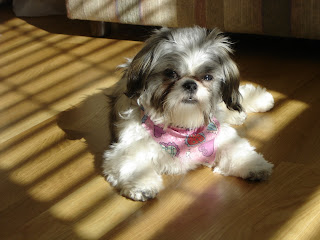Dogs are amazing products of human selection. Size, color, shapes of various body parts, and even behaviors are distinctive to particular breeds. The size range of adult dogs exceeds that of any other mammal, as wonderfully illustrated by the
cover of Science, as the issue announces the IGF1 locus as the major determinant of size in dogs.
This paper also illustrates how science can be a bit slow to get off the ground. About 15 years ago I heard a seminar from the senior author of this paper discussing the great promise of dog genetics to shed light on important medical and biological questions. In the meantime, there really haven't been much in the way of splashy dog genetics papers, though the community has been slowly building up a cache of tools. I think it is a reasonable expectation that this paper will be the head end of a series of papers unleashing the promise of the field.
After all, consider my diminutive assistant.
 . If you line her up with a Scottish terrier, while they are about the same size they have little else in common in their basic shape. Amanda has the flat face characteristic of her tong (The Ancient and Honourable Order of the Shih Tzu), whereas the Scottie has a distinctive snout which marks his clan. Her tail could honestly mistaken for a feather duster, whereas the terrier's has a less severe curl and isn't fluffy. A Scottie has erect ears; a Shih Tzu's are floppy. Each one of those characters could probably land a paper isolating them in a good journal. Perhaps even more striking would be the identification of a locus leading one of the sterotyped behaviors of a working dog. Half of Dr. Ostrander's seminar 1111 years ago (hey, this is an informatics blog!) was video of border collies herding sheep -- and ever since I can't watch a border collie playing with a frisbee or playing with kids and think of it except in terms of herding.
. If you line her up with a Scottish terrier, while they are about the same size they have little else in common in their basic shape. Amanda has the flat face characteristic of her tong (The Ancient and Honourable Order of the Shih Tzu), whereas the Scottie has a distinctive snout which marks his clan. Her tail could honestly mistaken for a feather duster, whereas the terrier's has a less severe curl and isn't fluffy. A Scottie has erect ears; a Shih Tzu's are floppy. Each one of those characters could probably land a paper isolating them in a good journal. Perhaps even more striking would be the identification of a locus leading one of the sterotyped behaviors of a working dog. Half of Dr. Ostrander's seminar 1111 years ago (hey, this is an informatics blog!) was video of border collies herding sheep -- and ever since I can't watch a border collie playing with a frisbee or playing with kids and think of it except in terms of herding.Many other domesticated animals have a large number of interesting breeds, but never quite as varied as dogs. Dogs were simply bred for more roles than cats, pigs, horses, cows or rabbits -- leading the selection of a wider variety of traits.
Yes, dog genomics promises to dig out some interesting biology, to fetch new insights into the genetics of morphology and behavior. When it comes to the secrets of the mammalian genome, we must not let sleeping dogs lie.
2 comments:
Such an excellent (bioinformatic) post. I'm lloking at my dog right now.
frédéric
Nice hairstyles for dog Shih Tzu Haircuts
Post a Comment